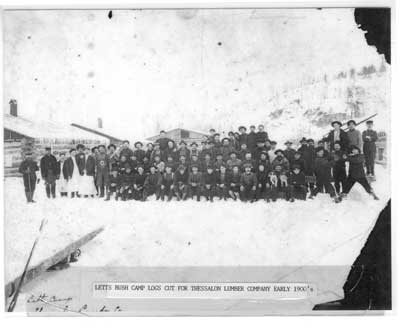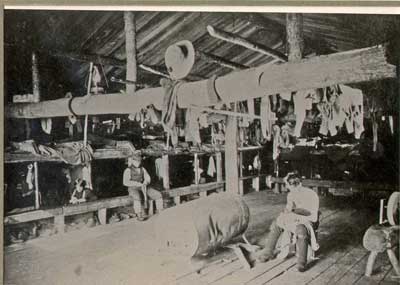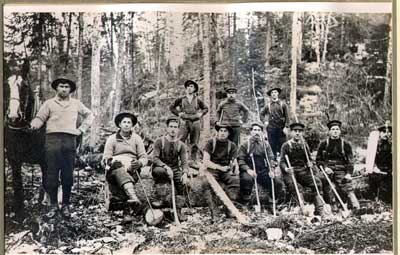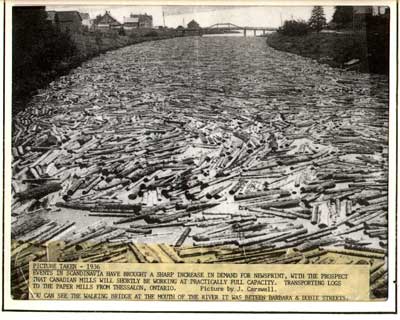From Forest to Factory
Mill Life
Pages
IntroductionTimelineMill LifeDyment MillGordon MillBurtis MillThessalon Lumber Company, NestorvilleSaginaw MillHope MillBishop Lumber Company, NestorvilleCrane Lumber MillMidway Lumber and Birchland VeneerHolcombe Mills, Little RapidsMilltown MillClinton MillShaw MillThessalon Woolen MillAsam Basket FactoryAlgoma Customs and Smelting Co., ThessalonFirstbrook Box Factory, 1919 - early 1930sLinks
Thessalon Lumber Company, NestorvilleDyment MillGordon MillBurtis MillSaginaw MillHope MillCrane Lumber MillFirstbrook Box Factory, 1919 - early 1930s
Crawfords's Logging Camp, Circa 1908 Details
Logging camps were usually established in August or September and functioned throughout the winter months. Buildings were constructed with readily available materials and typically had five main buildings - cookery, sleep camp, office, stable, and a blacksmith.

Loggers at Lett's Bush Camp, Thessalon, Ontario, circa 1900 Details
Lett's bush camp supplied cut logs for the Thessalon Lumber Company in the early 1900s.
Some of the loggers were settlers who worked in the lumber camps during winters and farmed during the summers.
Some of the loggers were settlers who worked in the lumber camps during winters and farmed during the summers.

Bunk House, Thessalon Area, circa 1910
Details
This photo is a representation of a typical logging camp bunkhouse where the men spent most of their off hours, sleeping or playing cards.

Thessalon area - Group of Lumberjacks, circa 1900
Details
The life of a lumberman was not easy. Men were measured by their productivity, "with loggers counting their daily cut in hundreds of pieces". Days were long, sometimes starting before dawn and could extend into the night.
Monthly wages were low by today's standards ranging from $13 for a chore boy to $50 for a cook, $60 for a foreman, and typically $1/day for all others plus board.
Monthly wages were low by today's standards ranging from $13 for a chore boy to $50 for a cook, $60 for a foreman, and typically $1/day for all others plus board.

Brag Load of Logs, Circa 1900 Details
This is a good example of a "brag" load of logs typically pulled by a single team of horses. A skilled team of men would work together using cant hook, swamp hook, decking line, and chains would mount these logs.

Transporting Logs by River, Thessalon, 1936
Details
Here is a view of the Thessalon River full of logs moving towards Lake Huron where they were shipped out, or were directed to the mills located along the waterfront for processing.

Former mill and box factory site, Thessalon Details
Many of the logs brought into Thessalon were processed at one of the mills along the shoreline while others were shipped out. Some of the wood was also used for secondary industry such as the Firstbrook Box Factory.

Loading Lumber, Thessalon Dock, circa 1900
Details
The "end of the line" for some of the logs from the north shore!
This lumber once loaded onto a large freighter, (predominant method of transport in the early logging days), was then shipped off to market.
While this cycle was finished, the process from "Forest to Factory" would be repeated many times over in the future.
This lumber once loaded onto a large freighter, (predominant method of transport in the early logging days), was then shipped off to market.
While this cycle was finished, the process from "Forest to Factory" would be repeated many times over in the future.
